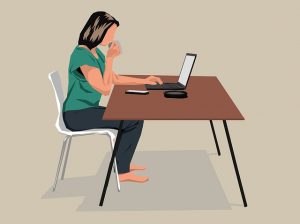 When you went to college, they probably didn’t teach you how to sit all day and not get back pain or carpal tunnel.
When you went to college, they probably didn’t teach you how to sit all day and not get back pain or carpal tunnel.
When you started your career, you probably did not learn how to use your body to avoid injury.
During your new employee orientation, they probably didn’t mention injury prevention.
In our society, it is not common practice to teach workers how to properly use their bodies to avoid injury while at work, whether standing, sitting, or moving around.
In Physical Therapy school, a large part of our education is learning proper body mechanics. In other words, we’re taught how to use our bodies safely to avoid injuring ourselves when working with patients and then how to teach proper body mechanics to our patients. For example:
- We learn the best posture techniques for ourselves when helping someone stand from a chair or move in bed, bend down when working with someone’s feet, or how to sit properly while using our hands on people without hurting our backs.
- When using our hands to manipulate tissue, we learn how to keep the joints of our fingers and wrists in the best alignment, so as not to cause degeneration or injury.
- When lifting a body part such as a leg to assess for joint range of motion or knee ligament injury, we learn to stand and use our arms/body in a way to decrease our possibility of injury.
- We also gain a self-awareness of our own limitations when helping a patient, so we ask a colleague to help.
Workplace wellness strategies are important for everyone, not just physical therapists. As part of my commitment to community outreach, I offer a free workplace wellness presentation with tips on how to make it through the day and not get injured. The following are some of the tips I offer for people to avoid injury while at work and moving throughout their daily life:
Standing posture: How to be mindful when standing
 We often have to stand in lines at the store, at a social event, waiting for the train or bus, washing dishes, or at a standing desk. Maintaining good posture or alignment prevents you from irritating yourself.
We often have to stand in lines at the store, at a social event, waiting for the train or bus, washing dishes, or at a standing desk. Maintaining good posture or alignment prevents you from irritating yourself.
- Stand evenly over both feet, shoulder width apart, do not lean more on one hip
- Relax shoulders by lowering your chest and do not over-pull shoulder blades back
- Keep you abs engaged (watch this video for a neat trick)
- Find your center of balance over your whole feet (watch this video to learn how)
Tips for using a standing desk to prevent tight hips:
- Alternate standing/sitting throughout the day
- Use a standing desk every 2-3 hours for 30-90 min – build up to longer times
- Maintain good posture
- Wear flatter shoes with support – no high heels
- Get up every hour to hour and half to move around
- Take a 5 min walk
- Exercise at your desk
- Stand on 1 leg
Good posture: How to be mindful of “sitting up”
 Traditional advice from the time you were small rears its ugly head again. Whenever you’re in the seated position, try these tips to regain your posture and improve sitting comfort:
Traditional advice from the time you were small rears its ugly head again. Whenever you’re in the seated position, try these tips to regain your posture and improve sitting comfort:
- Place your knees lower than your hips, a wedge under can help
- Use a lumbar support pad behind the small of your back to support the normal curvature of the spine and promotes proper posture
- Choose a firm chair over something mushy that will compromise the position of your back
- Keep your feet flat on the floor; do not cross your legs
- Sitting the majority of your day will set you up for a boatload of issues as outlined in this great infographic and this blog post
- Arms at 90 degrees with desk
- Explore different mice, wrist supported mouse pads, different keyboards
More info to keep you safe at work
- Use stairs instead of elevators, but make sure you use proper form (learn how to climb stairs safely in this video)
- Drink plenty of water, as buildings are notoriously dry
- Dehydration is common, so set a reminder to drink every hour. Common signs of dehydration include dry mouth, head achy, tired
- Perhaps add-in an electrolyte drink such as coconut water that does not have added sweeteners
- Use a backpack or rolling bag instead of a bag over 1 shoulder
- Always use a headset when on the phone to prevent neck, shoulder and elbow pain
- Use your core when opening a door – keep your elbow bent, instead of pulling door with your arm, step back in order to use your body to open the door
- Watch my webinar on The Downside of Working from Home: Back and Neck Pain
The 2-minute exercise routine you can do at your desk
With these exercises, if you feel pain or discomfort with any of the following exercises, re-adjust how you are doing exercise by checking your position and be sure you are using your glutes. If that doesn’t work then don’t do that particular exercise. This routine can be done as a whole or piecemeal throughout the day:
- Raise arms overhead to side, deep breath in, breathe out as arms come down – 3-5
- Shoulder roll: forward 3x, backward 3x
- Hip stretches – hands on hips – you should not feel any pain or movement in your back
- Move hips forward/backward 4x
- Move hips side/side 4x
- Rotate hips 4x
- Heel raises – raise up on your toes and lower down 10x
- Single leg balance
- Side lunge 5x each direction
- Squat to chair 5-10x

Is There a Solution for Lower Back Pain?
Are you struggling with lower back pain or sciatica? Is it keeping you from doing the activities you enjoy? If so, I’d like to invite you to our FREE workshop to learn the 3 main causes and how to heal naturally.
Click here to sign up for this free monthly workshop and learn how to get your life back.






Leave a Reply